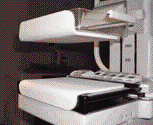A study of Swedish and American women presented at the annual meeting of the Radiological Society of North America (RSNA) finds that a new pad consisting of a soft-form cushion helps reduce discomfort associated with mammography. Experts estimate that fear of discomfort discourages 40% of women from receiving annual screening mammography, an exam that helps detect breast cancer in its earliest stages. The new product, called the Mammopad, was found to reduce mammography discomfort by 50% without affecting the quality of the mammogram films. The Mammopad is a single-use, adhesive-backed cushioned pad that can be applied to both the mammographic plate and the breast compression paddle before a mammogram. Because the pad is radiolucent, it is invisible on a mammogram film. It does not obscure any breast tissue and does not cause artifacts (image distortions) on the mammogram. The Mammopad has received clearance from the U.S. Food and Drug Administration (FDA). In the study with the Mammopad, Swedish mammographer Laszlo Tabar, MD and researchers from the MemorialCare Breast Center in Laguna Hills, California assessed the pad’s effects on 505 women at the California facility and 838 women at Falun Central Hospital in Falun, Sweden. Each woman underwent mammography on both breasts; the pad was used on one breast but not the other. After mammography, the women were asked to complete a survey about their comfort during the exam. Dr. Tabar and his colleagues found that the mammography pad reduced discomfort for 74% of the American women and 66% of the Swedish women. On average, discomfort among these women decreased by 50%. Furthermore, women reported that the pad helped to provide a softer and warmer mammogram. "These findings indicate there is a substantial clinical benefit to the breast cushion," according to Susan Roux, MD, a radiologist from MemorialCare Breast Cancer who presented the study results at the annual meeting of the RSNA in November 2001. The American Cancer Society and several other organizations recommend that all women 40 years of age and older receive annual screening mammograms to help detect breast cancer early, when the chances of successful treatment and survival are the greatest. Some women younger than age 40 may also need annual mammograms if they are at high risk of breast cancer and instructed by their physicians to receive the exam. Many women identify breast compression as the portion of the exam that tends to cause discomfort. Breast compression is directly responsible for the image quality of a mammogram. During mammography, breast compression is applied two to four times per breast for a few seconds for each mammogram view. Breast compression is necessary during mammography in order to:
Experts hope the new pad will increase comfort during mammography and encourage more women to undergo the exam. In addition to mammography, all women 40 years of age and older should also receive annual physician-performed clinical breast exams and practice monthly breast self-exams. Women between the ages of 20 and 39 should receive clinical breast exams at least every three years and practice monthly breast self-exams. The MammoPad is not yet available at many mammography facilities. Women interested in receiving a mammogram with the pad should tell their physicians. Please see the references section below for more information.
|




